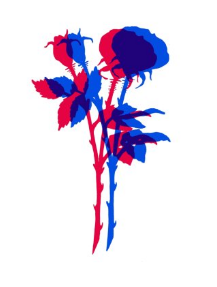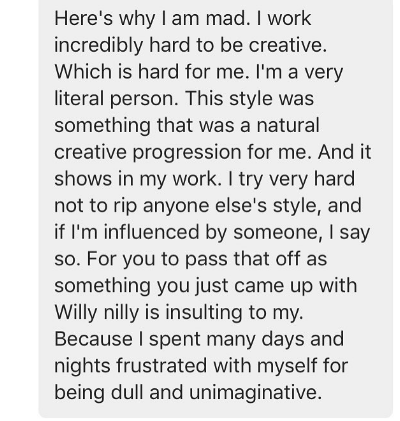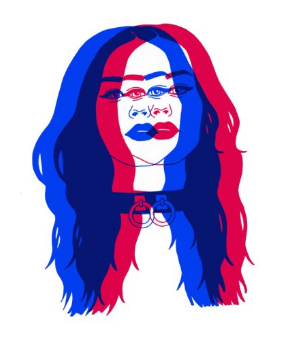How to Know if Someone Is Stealing Your Art
They say "imitation is the best form of flattery". But whatsoever creative would expect at that and call BS. Getting your art stolen, reposted and claimed as someone else's, or having your way copied is the worst. Such is the harsh reality of being an artist (or any creative, actually). While a workinspiredby your mode or an art piece you've washed tin indeed be flattering (with proper credit), when someone is claiming your work as their own? That can feel awful, and y'all need to shut 'em down.
Just how do you go about doing that? And more than and then, how practise you protect your work from getting stolen in the kickoff place?We talked to two people with a lot of feel in this expanse: an Artist Store owner who has had her work stolen more than a few times, and the co-founder of the copyright-made-easy site, Binded.com. They allow us in onhow to protect your art from getting stolen and what to practise if it'south already been stolen.
. . .
From an Artist's Perspective
I Artist Shop possessor who has struggled with people stealing her art is Monica, the possessor of the "Earth to Monica" Artist Store. She's dealt with people both reposting her work equally their own, as well every bit copying work of hers and her unique mode. She's been very public almost this struggle, and we talked to her a footling bit near what she does when her art is stolen or reposted.

I've seen on Instagram that you've had to bargain with quite a few copycat artists ripping off your style – how exercise you get nearly handling this?
In the beginning, information technology used to drive me bananas because I was still sort of honing this way. It felt like people saw something that worked for me and all hopped on the bandwagon. If information technology was a dead ringer for 1 of my pieces, I would bulletin them with as much kindness every bit I could muster (which took soooo much attempt for me; I'm a fiery Leo, haha) and inquire them to credit inspo or remove it completely. I've had someone copy my work exactly every bit information technology was and call it hers. That was infuriating.
The others that are more than simply in my style and not exactly like mine don't carp me every bit much. I've learned over fourth dimension to sort of take it equally flattery. I exercise become a lot of people who volition do a piece like mine, tag me, and tell me what an inspiration I am. That'southward the way to do it! Those actually make me feel prissy haha.

How exercise you find or wait for work that is copying your own?
I don't look for information technology anymore. Simply I do get messages from my followers linking me to accounts of copycats, or even people but using my images with no credit. I but love my followers and then much.
They say "faux is the best form of flattery", just I recollect artists would beg to differ! What, to you lot, separates a piece of work existence 'inspired by' someone else's style and just obviously stealing?
Haha, I still struggle with information technology feeling similar flattery similar I mentioned earlier. I think information technology's fine to do a piece in the way of another artist, equally long as y'all withal notice a manner to put your mark on it. Like drawing the same subject matter or in the same style with your own twist. Straight up redrawing someone else'south slice is stealing for sure.
What are some resources yous know of that artists can employ when they think their art has been stolen?
Definitely not the customer back up at IG; they were no aid at all. There's really non much you can do every bit an creative person if that happens, unfortunately, other than legal proceeding. I've seen it happen to a lot of artists, and I've seen masses

of IG users rally up and bombard whoever the thief is. Whether or not there was an terminate upshot to all that, I'm unsure. Like with the whole Tuesday Bassen vs Zara affair.
What are some things yous exercise to ensure your work isn't stolen, or if it is you then have proof information technology was originally yours?
I've seen a lot of people start watermarking their piece of work when they post online. I try to use kind of a crappy moving picture that no one would want to steal. I e'er keep my sketches and try to have everything filed sort of chronologically on my computer. Someone recently drew the same thing as me after I had done it, and we concluded up making a pin of the piece I did. I got called a thief! Only was able to prove that I had done information technology outset! Booyah! Haha
From a Copyright Professional's Perspective:
Let's say y'all want to exist more than proactive nearly protecting your work with some legal backing that carries some weight. We also talked to Nathan Lands at Binded.com – a relatively new resource in the copyright game. Binded promises to make copyrighting your work super easy by managing your copyrights for free, which nosotros call back is pretty cool. Cheque out what Nathan had to say about what to do when your work is stolen.
What are some steps that creatives can accept to protect their work from being stolen?
That's a bang-up question. Here are a few simple steps creators can take to protect their work:
- Keep records of thecopyrights you lot ain. Y'all need to keep track of your piece of work and when they were created and published. Very few people do this but it is important. If y'all're not keeping track of yourcopyrights, it's hard to protect them.
- Put acopyright notice next to your piece of work. For instance, "Copyright©️ 2017 Your Proper name. All rights reserved." Near people think you lot need to register yourcopyright to employ the ©️ symbol. You lot don't!
- Monitor yourcopyrights for infringement. Most people don't do this, and information technology's probably the near important pace to protecting your work. Some people manually check with Google image search, which fourth dimension-consuming.Binded is working on making it piece of cake to automatically monitor yourcopyrights for free.
- Annals with the U.S.Copyright Function. For at present, it's notwithstanding necessary to annals with the USCO to win statutory damages upward to $thirty,000 and have your legal fees paid. So for work you really value, you should register it with the USCO.
When a creative notices that their work has been ripped off, what'southward the best step for them to have?
If possible, you lot should immediately contact acopyright lawyer. If you experience the infringement is minor or you don't accept the upkeep for a lawyer, you can effort taking action yourself.
First, information technology's of import to determine if you're dealing with acopyright infringement or not. To determine that, you lot need to sympathize the term "off-white use". In full general, if someone is using yourcopyrighted work for commentary or one-act, information technology may autumn under off-white use.
If it's non fair employ, then you should determine if it's a user-generated content site or non. E.grand. Etsy, Youtube etc. If it is, yous can send a DMCA take down detect. The process is pretty straight forwards and the company must reply to your request. Usually, they'll have the work downward pretty quickly.
If yous're dealing with a company that's infringing, you lot tin can try sending a cease and desist letter of the alphabet. The letter of the alphabet tin can include proof of yourcopyright, a link to the infringement, and a request to take it down. We're working on solutions to make all of this a whole lot simpler.
"Nigh people call up you need to register yourcopyright to apply the ©️ symbol. Yous don't!"
What are some ways someone can prove piece of work is theirs if it's been taken?
When nosotros created Binded, we interviewed artists, photographers, and designers. Most of them told us that they ship a link to their website or Instagram as "proof". Which obviously isn't taken very seriously past the recipients.
With Binded, we're working on making information technology a lot easier to testify you created your work. We create a permanent fingerprint of every imagecopyright on Binded. Soon we'll requite you ways to share that proof with others, which is going to look a lot more than reputable and serious. We're as well working on plugins for all pop artistic tools, like Lightroom and Photoshop. We're going to make information technology elementary to create proof at time of creation with whatsoever tools yous already use. Then when you create something it's binded and very hard to dispute who created it.
What is the most common state of affairs yous've seen where people'southward work is being stolen?
There are and so many different situations that are common that we could write a whole blog post simply on that. It's really a bigger trouble than most people realize. A common state of affairs is fashion brands using artwork and photos without permission. We hear nearly this a lot. That'south why I recollect it's awesome that Threadless is a platform that really supports creators.
We're starting to collect data oncopyright infringements. The surprising thing is how big the names are involved. For now, we're not going to proper noun anyone, only in the future, we may publish a study of what we've plant. The results are pretty shocking. I'grand certain many companies don't do it on purpose. But some are definitely doing it on purpose and consider information technology a cost of doing business concern. They probably think most creators aren't monitoring theircopyrights because it's as well difficult or expensive. And then most people will never find out about information technology. We're going to change that.
TL;DR
Here's the quick gist of what to do to forbid your art from getting stolen:
STEPS TO PREVENT SOMEONE STEALING YOUR Work:
- Watermark your work on social media: this makes it harder for someone to take your art and makes information technology impossible for someone to directly up screenshot and repost your posts.
- Sign information technology:never a bad idea to have a little signature well-nigh your work, and similar to watermarking!
- Keep your sketches:keep the process art from your design – go along photos of it or even postal service pictures of it so that y'all can bear witness that you a: started working on itbeforethe person who stole the piece of work posted it and b: can use that process art every bit proof that yes, this idea came from you.
- Mail service pictures of your work IRL:if it's a mitt fatigued slice, take a picture of information technology in your notebook with the pen y'all used to create it, or a moving-picture show of it on your desk.
- Add a copyright message:if you're posting on Instagram, add in the description section a little copyright with your name and the date, as well as a warning to please not repost your images (maybe fifty-fifty a picayune "I'm watching you ?" bulletin).
- Be squeamish to your fans:your fans and followers are a huge asset – they can warning you to people who might be trying to steal or re-create your work, and tin vouch for you as well.
- COPYRIGHT DAT WORK!Copywriting your piece of work isn't a bad price to pay for protecting it.
Related Posts
Source: https://creativeresources.threadless.com/how-to-protect-your-art-from-getting-stolen/
0 Response to "How to Know if Someone Is Stealing Your Art"
Post a Comment